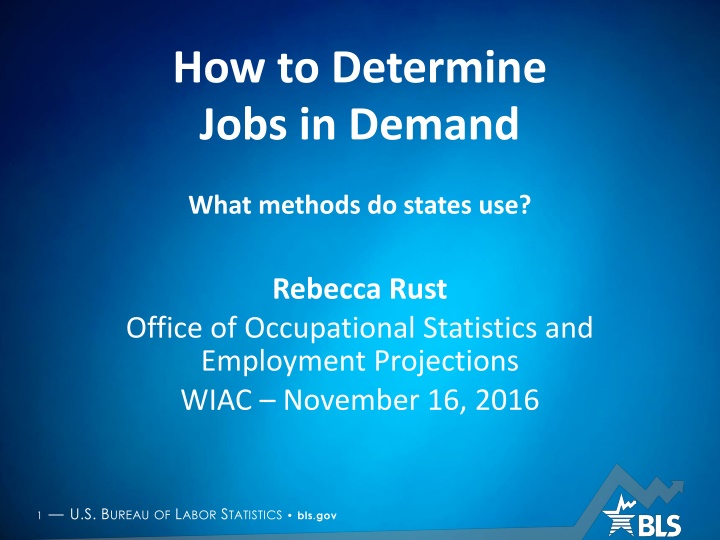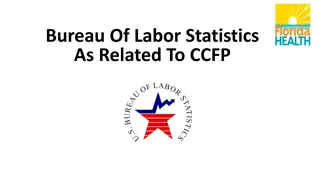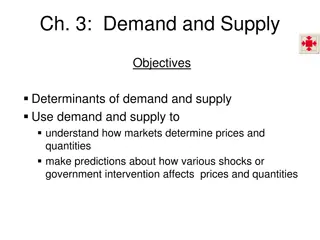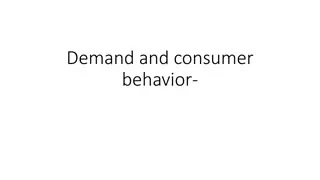
Methods for Determining In-Demand Jobs
Learn how states use methods, such as analyzing employment projections and wage data, to determine in-demand occupations for better education and training alignment. Find out about using BLS and state projections and future ways to assess job demand.
Download Presentation

Please find below an Image/Link to download the presentation.
The content on the website is provided AS IS for your information and personal use only. It may not be sold, licensed, or shared on other websites without obtaining consent from the author. If you encounter any issues during the download, it is possible that the publisher has removed the file from their server.
You are allowed to download the files provided on this website for personal or commercial use, subject to the condition that they are used lawfully. All files are the property of their respective owners.
The content on the website is provided AS IS for your information and personal use only. It may not be sold, licensed, or shared on other websites without obtaining consent from the author.
E N D
Presentation Transcript
How to Determine Jobs in Demand What methods do states use? Rebecca Rust Office of Occupational Statistics and Employment Projections WIAC November 16, 2016 1 U.S. BUREAU OF LABOR STATISTICS bls.gov
How To Determine Jobs in Demand Use of LMI can improve the alignment of education and training to better meet the hiring demands of business This can be done by determining in-demand occupations 2 U.S. BUREAUOF LABOR STATISTICS bls.gov 2 U.S. BUREAUOF LABOR STATISTICS bls.gov
How to Determine Jobs in Demand Using BLS and State/Area Projections Fastest growing occupations (by percent) from the state s Employment Projections program It could be all those occupations growing faster than the average or some other selected growth rate threshold percent Fastest growing occupations (by percent) from the state s Employment Projections program that also meet a selected wage threshold It could be those fastest growing occupations that pay a wage equal to or greater than $15.00 per hour, for example Fastest growing occupations (by percent) from the state s Employment Projections program that also meet a selected threshold for number of new jobs It could be those fastest growing occupations that also gain at least a 1,000 new jobs or more per year, for example 3 U.S. BUREAUOF LABOR STATISTICS bls.gov
How to Determine Jobs in Demand Using BLS and State/Area Projections Fastest growing occupations (by percent) from the state s Employment Projections program that come from specified targeted industries for economic development Manufacturing could be targeted, for example Fastest growing occupations (by percent) from the state s Employment Projections program for a specified education/training level It could be for the fastest occupations requiring more than a high school degree but less than a bachelor s degree, for example Highest number of new jobs (by specified level) from the state s Employment Projections program This listing could have thresholds added on as shown above, such as wages, targeted industries, and/or education levels 4 U.S. BUREAUOF LABOR STATISTICS bls.gov
Future Ways to Determine Jobs in Demand Using BLS Federal/State OES and Wage Data as a Time Series Data that are statistically designed to be measured and compared over time are a time series Occupations that have both positive employment and wage growth can indicate that demand is greater than supply This data series can be considered a new labor market indicator of current (or short-term) in- demand occupations 5 U.S. BUREAUOF LABOR STATISTICS bls.gov
How To Determine Jobs in Demand Using alternative data bases or customized employer needs Highest number of job openings or fastest gain in openings from a Job Vacancy Survey or Skills-Gap Survey This could be from a state survey that asks employers about unmet hiring needs Highest number of online job ads or fastest gain in job ads by occupation This could be from the state s job bank or other source, such as Help Wanted OnLine from the Conference Board, for example Highest number or fastest growing online job ads and/or those hardest to fill This could be reposted online jobs Largest gap between occupational demand and supply This could be comparing demand occupations (from Employment Projections or online ads) compared to supply (which could be training completers and job seekers registered in the state s career centers) Employer needs for customized training to meet specific hiring needs This could be from business partnerships, or a new firm opening up in an area, or from coordination efforts of business, workforce, economic development, and education all working together 6 U.S. BUREAUOF LABOR STATISTICS bls.gov
Improved alignment of education and training with the hiring needs of business using in-demand occupations does what? This improved alignment drives the allocation of training resources, leading to: Higher placement and retention rates Improved reemployment Lowered UI benefit and welfare costs Stronger business expansion and retention Expanded economic growth Improved standards of living 7 U.S. BUREAUOF LABOR STATISTICS bls.gov 7 U.S. BUREAUOF LABOR STATISTICS bls.gov
Contact Information Rebecca Rust Assistant Commissioner Office of Occupational Statistics and Employment Projections 202-691-5701 rust.rebecca@bls.gov 8 U.S. BUREAUOF LABOR STATISTICS bls.gov






















